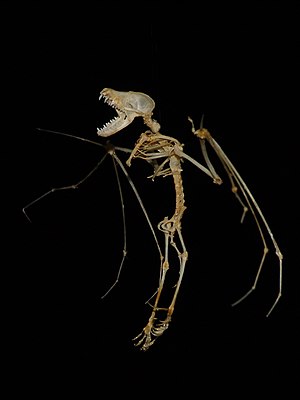Euteleostomi
| Euteleostomi | ||||||||||
|---|---|---|---|---|---|---|---|---|---|---|

Skeleton of a large mouse-eared bat (Myotis myotis) |
||||||||||
| Systematics | ||||||||||
|
||||||||||
| Scientific name | ||||||||||
| Euteleostomi | ||||||||||
| Nelson , 1994 |
The euteleostomi , also called neoteleostomi , neognathostomata , osteognathostomata or bone animals , are a taxon (a systematic group) used in phylogenetic systematics , to which, with the exception of the hagfish , lampreys and cartilaginous fish , all vertebrates living today - including of man - belong. They include the traditional but not monophyletic taxon bony fish (Osteichthyes) and the terrestrial vertebrates (Tetrapoda). The monophyletic sub-taxa of the Euteleostomi are the ray fins (Actinopterygii) and the muscle fins (Sarcopterygii), to which the terrestrial vertebrates must also be counted in the sense of cladistics .
features
The most important autapomorphies of the Euteleostomi are a bony inner skeleton, which can also largely be regressed to a cartilage skeleton (e.g. in the sturgeon-like ), and a skull articulated by bone sutures. Most euteleostomi have a swim bladder or a lung . A spiraculum is only present in some of the original groups. There is only a low concentration of urea and trimethylamine oxide in the blood (exceptions are lung fish and latimeria ). The osmotic equilibrium can only be maintained through an energy-consuming transfer process.
literature
- Joseph S. Nelson: Fishes of the World . John Wiley & Sons, 2006, ISBN 0-471-25031-7
Web links
- Animal Diversity Web Euteleostomi
- Entry in the NCBI taxonomy
Individual evidence
- ↑ Katharina Munk: Zoology. Georg Thieme Verlag 2010, p. 208